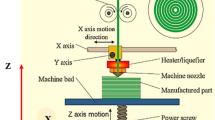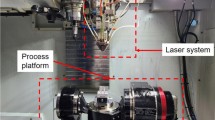Abstract
Fused deposition modelling has become one of the most popular extrusion additive manufacturing technologies over the last decades, since it is easy to handle and user-friendly. However, it still requires special attention regarding its position within different industrial applications; one of the major issues that require additional improvement corresponds to the surface quality. Hence, this work is dedicated to the understanding of the roughness according to three process parameters, namely, printing speed (Spd), layer thickness (Lth), and extrusion temperature (Temp). A Taguchi L27 orthogonal-array was adopted in order to conduct this investigation. Neither post-surface treatments nor any additional surface finishing were applied. Altisurf apparatus was utilized to build 3D images and 2D profiles of the samples’ peaks and depths leading to significant surface sampling regarding the statistical analysis that follows. From a quantitative standpoint, the arithmetic roughness Ra ranged between 7.18 and 13.4 µm, while the best surface quality was reached at the higher scan speed, 4000 mm/min; the smoothest surface was produced at the lowest value of the layer thickness, 0.1 mm; finally, the higher extrusion temperature is the best is the produced surfaces. Moreover, a multiway ANOVA was carried-out leading to select the most significant factors and interactions within the set of inputs. Consequently, the resulting analysis has discriminated the most influenced parameters within the following order, Lth, Spd, and the interactions Temp * Spd, and Lth * Temp. Future works will propose a semi-empirical method including fluid dynamics and thermodynamics involving stochastic parameters to understand roughness variability of FDM produced samples.







Similar content being viewed by others
Data availability
All data required are presented in the text.
References
Gibson I, Rosen D, Stucker B (2015) Additive manufacturing technologies: 3D printing, rapid prototyping, and direct digital manufacturing. Springer New York, New York. https://doi.org/10.1007/978-1-4939-2113-3
Hopkinson N, Hague RJM, Dickens PM (eds) (2006) Rapid manufacturing: an industrial revolution for the digital age. Chichester, England: John Wiley
Pant M, Singari RM, Arora PK, Moona G, Kumar H (2020) Wear assessment of 3–D printed parts of PLA (polylactic acid) using Taguchi design and artificial neural network (ANN) technique. Mater Res Express 7(11):115307
Wang R-J, Wang L, Zhao L, Liu Z (2007) Influence of process parameters on part shrinkage in SLS. Int J Adv Manuf Technol 33(5–6):498–504. https://doi.org/10.1007/s00170-006-0490-x
Fri K et al (2023) Microstructural and heat treatment analysis of 316L elaborated by SLM additive manufacturing process. Int J Adv Manuf Technol 124(7–8):2289–2297. https://doi.org/10.1007/s00170-022-10622-4
ISO/ASTM 52900:2021 — additive manufacturing — general principles — fundamentals and vocabulary. [Online]. Available: https://www.iso.org/standard/74514.html. Accessed 6 Mar 2023
Mohamed OA, Masood SH, Bhowmik JL (2015) Optimization of fused deposition modeling process parameters: a review of current research and future prospects. Adv Manuf 3(1):42–53. https://doi.org/10.1007/s40436-014-0097-7
Montero M, Roundy S, Odell D, Ahn S-H, Wright PK (2001) Material characterisation of fused deposition modeling (FDM) ABS by designed experiments
Ahn S, Montero M, Odell D, Roundy S, Wright PK (2002) Anisotropic material properties of fused deposition modeling ABS. Rapid Prototyp J 8(4):248–257. https://doi.org/10.1108/13552540210441166
Fernandez-Vicente M, Calle W, Ferrandiz S, Conejero A (2016) Effect of infill parameters on tensile mechanical behavior in desktop 3D printing, 3D Print. Addit Manuf 3(3):183–192. https://doi.org/10.1089/3dp.2015.0036
El Jai M, Saidou N, Zineddine M, Bachiri H (2021) Mathematical design and preliminary mechanical analysis of the new lattice structure: ‘GE-SEZ*’ structure processed by ABS polymer and FDM technology. Prog Addit Manuf 6(1):93–118. https://doi.org/10.1007/s40964-020-00148-0
Rangisetty S, Peel LD (2017) The effect of infill patterns and annealing on mechanical properties of additively manufactured thermoplastic composites. In: Volume 1: Development and characterization of multifunctional materials; mechanics and behavior of active materials; bioinspired smart materials and systems; energy harvesting; emerging technologies, Snowbird, Utah, USA, V001T08A017. https://doi.org/10.1115/SMASIS2017-4011
Sood AK, Ohdar RK, Mahapatra SS (2009) Improving dimensional accuracy of fused deposition modelling processed part using grey Taguchi method. Mater Des 30(10):4243–4252. https://doi.org/10.1016/j.matdes.2009.04.030
Alafaghani A, Qattawi A (2018) Investigating the effect of fused deposition modeling processing parameters using Taguchi design of experiment method. J Manuf Process 36:164–174. https://doi.org/10.1016/j.jmapro.2018.09.025
Lieneke T, Denzer V, Adam GAO, Zimmer D (2016) Dimensional tolerances for additive manufacturing: experimental investigation for fused deposition modeling. Procedia CIRP 43:286–291. https://doi.org/10.1016/j.procir.2016.02.361
Xu F, Wong YS, Loh HT (2000) Toward generic models for comparative evaluation and process selection in rapid prototyping and manufacturing. J Manuf Syst 19(5)
Anitha R, Arunachalam S, Radhakrishnan P (2001) Critical parameters influencing the quality of prototypes in fused deposition modelling. J Mater Process Technol
Byun HS, Lee KH (2006) Determination of optimal build direction in rapid prototyping with variable slicing. Int J Adv Manuf Technol 28(3–4):307. https://doi.org/10.1007/s00170-004-2355-5
Saad MS, Nor AM, Baharudin ME, Zakaria MZ, Aiman AF (2019) Optimization of surface roughness in FDM 3D printer using response surface methodology, particle swarm optimization, and symbiotic organism search algorithms. Int J Adv Manuf Technol 105(12):5121–5137. https://doi.org/10.1007/s00170-019-04568-3
Jee H, Sachs E (2000) Surface macro-texture design for rapid prototyping. Rapid Prototyp J 6(1):50–60. https://doi.org/10.1108/13552540010309877
Lalehpour A, Janeteas C, Barari A (2018) Surface roughness of FDM parts after post-processing with acetone vapor bath smoothing process. Int J Adv Manuf Technol 95(1–4):1505–1520. https://doi.org/10.1007/s00170-017-1165-5
Vahabli E, Rahmati S (2017) Hybrid estimation of surface roughness distribution in FDM parts using analytical modeling and empirical investigation. Int J Adv Manuf Technol 88(5–8):2287–2303. https://doi.org/10.1007/s00170-016-8949-x
Jiang S, Hu K, Zhan Y, Zhao C, Li X (2022) Theoretical and experimental investigation on the 3D surface roughness of material extrusion additive manufacturing products. Polymers 14(2):293. https://doi.org/10.3390/polym14020293
Rahmati S, Vahabli E (2015) Evaluation of analytical modeling for improvement of surface roughness of FDM test part using measurement results. Int J Adv Manuf Technol 79(5–8):823–829. https://doi.org/10.1007/s00170-015-6879-7
Ouazzani K, El Jai M, Elfahime B (2022) Detailed classification of FDM (fused deposition modeling) process parameters and potentially affected part characteristics. In: 2022 2nd International Conference on Innovative Research in Applied Science, Engineering and Technology (IRASET). IRASET, Meknes, pp 1–9. https://doi.org/10.1109/IRASET52964.2022.9738432
Thrimurthulu K, Pandey PM, Reddy NV (2004) Optimum part deposition orientation in fused deposition modeling. Int J Mach Tools Manuf 44(6):585–594. https://doi.org/10.1016/j.ijmachtools.2003.12.004
Chohan JS, Singh R (2017) Pre and post processing techniques to improve surface characteristics of FDM parts: a state of art review and future applications. Rapid Prototyp J 23(3):495–513. https://doi.org/10.1108/RPJ-05-2015-0059
Moore JD (1973) Acrylonitrile-butadiene-styrene (ABS) — a review. Composites 4(3):118–130. https://doi.org/10.1016/0010-4361(73)90585-5
Mercier JP, Zambelli G, Kurz W (2002) Introduction to the material science (French)- Traité des Matériaux, 3rd edn. Presses Polytechniques et Universitaires Romandes, Lausanne
Carrega M, Verney V (2017) Plastic materials (French), 4th edn. Dunod, Malakoff
Alkhuder A (2014) Structuration des mélanges ABS/PC en vue du recyclage des DEEE. Conservatoire national des arts et métiers - CNAM. [Online]. Available: https://theses.hal.science/tel-01132493
Wypych G (2012) Handbook of polymers. ChemTec Edition
“Stratasys ABS-M30 Datasheet -FDM Thermoplastic Filament-.” Accessed: Mar. 07, 2023. [Online]. Available: https://www.stratasys.com/siteassets/materials/materials-catalog/fdm-materials/abs-m30/mds_fdm_abs-m30_0921a.pdf
Ananthapadmanabha GS, Deshpande VV (2016) Thermal properties of acrylonitrile butadiene styrene composites. Indian J Adv Chem Sci S1:279–282
Praveen RN, Muruli D, Sandesh SN (2013) Tribological characteristics of acrylonitrile-butadiene-styrene (ABS) thermoplastic composites. Int J Mech Eng Robot Res 2(4)
Wilkes CE, Summers JW, Daniels CA, Berard MT (eds) (2005) Hanser, Munich; Cincinnati
Torrado Perez AR, Roberson DA, Wicker RB (2014) Fracture surface analysis of 3D-printed tensile specimens of novel ABS-based materials. J. Fail. Anal. Prev 14(3):343–353. https://doi.org/10.1007/s11668-014-9803-9
Weng Z, Wang J, Senthil T, Wu L (2016) Mechanical and thermal properties of ABS/montmorillonite nanocomposites for fused deposition modeling 3D printing. Mater Des 102:276–283. https://doi.org/10.1016/j.matdes.2016.04.045
Romanova N, Shafigullin L, Gabdrakhmanov A, Buyatova S (2019) Thermal properties of products based on ABS/PC. In: MATEC Web of Conferences 298:00016. https://doi.org/10.1051/matecconf/201929800016
Kumar V, Singh R, Ahuja IPS (2020) On mechanical and thermal properties of cryo-milled primary recycled ABS. Sādhanā 45(1):80. https://doi.org/10.1007/s12046-020-1317-4
Lyon RE, Janssens ML (2005) Polymer flammability. Office of Aviation Research, Washington, DC
Rahman M, Schott NR, Sadhu LK (2016) Glass transition of ABS in 3D printing. In: Proceedings of 2016 COMSOL Conference. COMSOL, Boston
Song B (2022) Study on dielectric and thermal properties of ABS/multilayer graphene composites. J Phys Conf Ser 2247(1):012011. https://doi.org/10.1088/1742-6596/2247/1/012011
Mondal A, Sohel MdA, Arif PM, Thomas S, SenGupta A (2021) Effect of ABS on non-isothermal crystallization kinetics of polyamide 6. J Therm Anal Calorim 146:2489–2501
Selvamani SK et al (2019) 3D printing: overview of ABS evolvement. In: Proceedings of the 3rd International Conference on Automotive Innovation Green Energy Vehicle. AIP, Kuantan, p 020041. https://doi.org/10.1063/1.5085984
Amendola C et al (2021) Optical characterization of 3D printed PLA and ABS filaments for diffuse optics applications. PLOS ONE 16(6):e0253181. https://doi.org/10.1371/journal.pone.0253181
Salman SR, Al-Shama’a ND (1991) Effect of thermal aging on the optical properties of ABS plastics. Polym-Plast Technol Eng 30(4):343–349. https://doi.org/10.1080/03602559108021000
Ferreira SLC et al (2007) Box-Behnken design: an alternative for the optimization of analytical methods. Anal Chim Acta 597(2):179–186. https://doi.org/10.1016/j.aca.2007.07.011
Soffie SM, Ismail I, Nurain MA, Aqida SN (2020) The morphological and surface roughness of magnetorheological polished AISI 6010 surface
Rajesh N, Guru Mahesh G, Venkataramaiah P (2022) Study of machining parameters on tensile strength and surface roughness of ABS samples printed by FDM. Adv Mater Process Technol 8:1373–1385. https://doi.org/10.1080/2374068X.2021.1946758
Roy RK (2010) A primer on the Taguchi method, 2nd edn. Society of Manufacturing Engineers, Dearborn, Mich
Explanation of surface characteristics—standards. Accretech-Tokyo Seimitsu. [Online]. Available: https://inspectionengineering.com/wp-content/uploads/2018/03/SurfaceFinishExplain.pdf
Gadelmawla ES, Koura MM, Maksoud TMA, Elewa IM, Soliman HH (2002) Roughness parameters. J Mater Process Technol 123(1):133–145. https://doi.org/10.1016/S0924-0136(02)00060-2
Kattethota G, Henderson M (1998) A visual tool to improve layered manufacturing part quality
Badola M, Vaishya RO (2016) Parameters affecting surface roughness of fused deposition modeling. Manag J Mech Eng 6(1):34. https://doi.org/10.26634/jme.6.1.3739
Chohan JS et al (2022) Optimization of FDM printing process parameters on surface finish, thickness, and outer dimension with ABS polymer specimens using Taguchi orthogonal array and genetic algorithms. Math Probl Eng 2022:1–13. https://doi.org/10.1155/2022/2698845
Pérez M, Medina-Sánchez G, García-Collado A, Gupta M, Carou D (2018) Surface quality enhancement of fused deposition modeling (FDM) printed samples based on the selection of critical printing parameters. Materials 11(8):1382. https://doi.org/10.3390/ma11081382
Hall DC, Palmer P, Ji H-F, Ehrlich GD, Król JE (2021) Bacterial biofilm growth on 3D-printed materials. Front Microbiol 12:646303. https://doi.org/10.3389/fmicb.2021.646303
Han W, Jafari MA, Danforth SC, Safari A (2002) Tool path-based deposition planning in fused deposition processes. J Manuf Sci Eng 124(2):462–472. https://doi.org/10.1115/1.1455026
EhsanulHaque M, Banerjee D, Bikash Mishra S, Kumar Nanda B (2019) A numerical approach to measure the surface roughness of FDM build part. Mater Today Proc 18:5523–5529. https://doi.org/10.1016/j.matpr.2019.07.659
Author information
Authors and Affiliations
Corresponding author
Ethics declarations
Ethics approval and consent to participate
None.
Consent for publication
None.
Conflict of interest
The authors declare no competing interests.
Additional information
Publisher's Note
Springer Nature remains neutral with regard to jurisdictional claims in published maps and institutional affiliations.
Rights and permissions
Springer Nature or its licensor (e.g. a society or other partner) holds exclusive rights to this article under a publishing agreement with the author(s) or other rightsholder(s); author self-archiving of the accepted manuscript version of this article is solely governed by the terms of such publishing agreement and applicable law.
About this article
Cite this article
Ouazzani, K., El Jai, M., Akhrif, I. et al. An experimental study of FDM parameter effects on ABS surface quality: roughness analysis. Int J Adv Manuf Technol 127, 151–178 (2023). https://doi.org/10.1007/s00170-023-11435-9
Received:
Accepted:
Published:
Issue Date:
DOI: https://doi.org/10.1007/s00170-023-11435-9






















